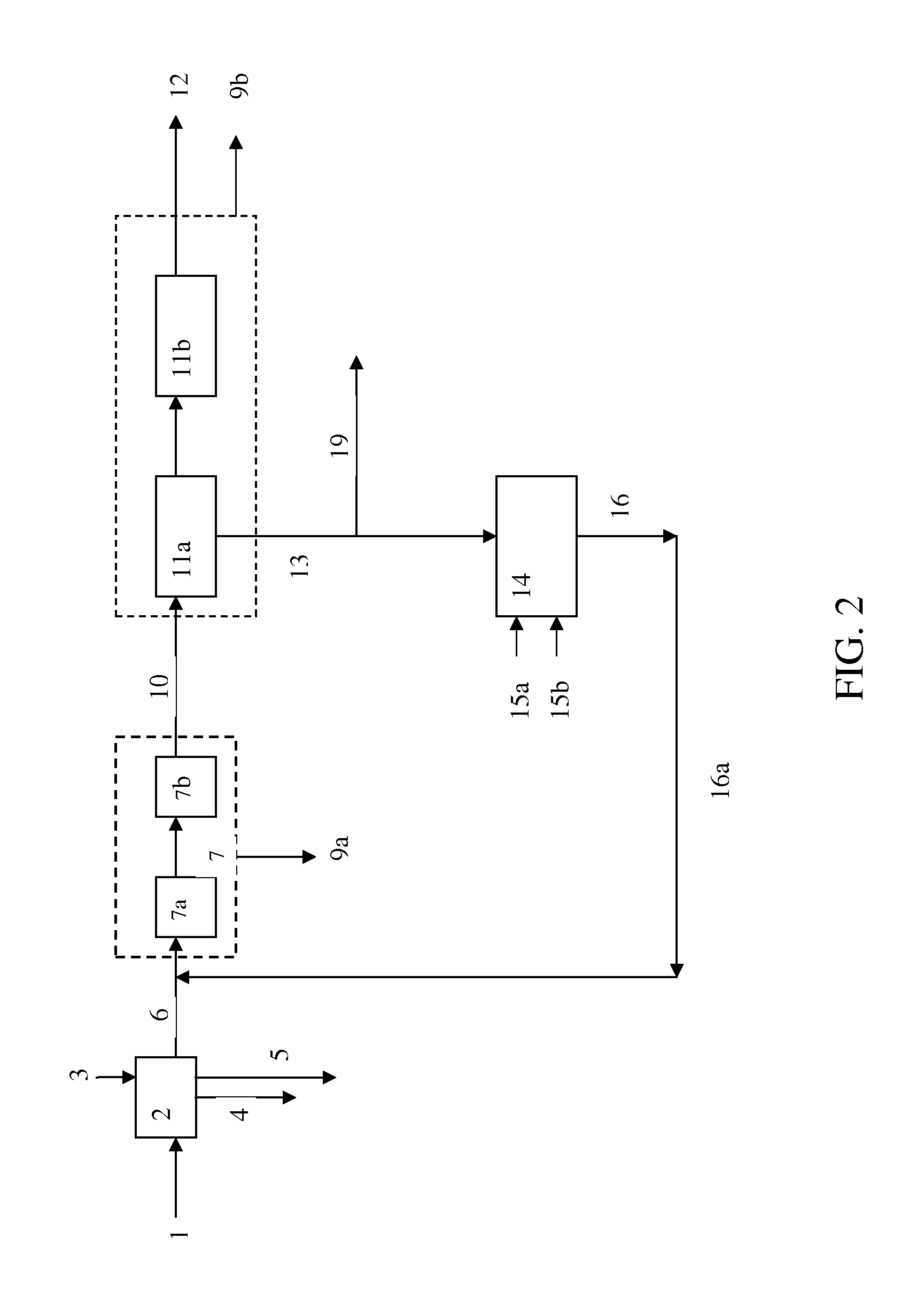Method for producing ethanol and solvents from lignocellulosic biomass including the recirculation of a butyl wine obtained by fermenting pentoses
a technology of lignocellulosic biomass and ethanol, which is applied in the direction of biofuels, fermentation, etc., can solve the problems of difficult economic validity of this type of process for the production of alcohol and/or solvents, and the inability to directly access enzymes,
- Summary
- Abstract
- Description
- Claims
- Application Information
AI Technical Summary
Benefits of technology
Problems solved by technology
Method used
Image
Examples
example 1
Not in Accordance with the Invention
[0106]A process for the production of ethanol, butanol and acetone starting from “Kraft”-type papermaking paste is considered. The paste is obtained starting from “softwood” wood that is pretreated in a Kraft-type papermaking process, which is an alkaline process in the presence of soda. The lignin-poor paste that is obtained from Kraft is then washed and neutralized and then introduced into the process for conversion of cellulosic substrate into ethanol by enzymatic hydrolysis and fermentation of glucose and mannose (sugars with 6 carbon atoms).
[0107]The process treats 52 tons / hour of paste (dry material base). The composition of the dry material is as follows:
Cellulose (%) 40%Xylans (%)7.5%Mannans (%)7.5%Lignin (%) 33%Others (%) 12%
[0108]During pretreatment, the losses of cellulose and hemicellulose are on the order respectively of 1.5 and 50.7%. At the outlet of the pretreatment, the level of dry material is 59%.
[0109]The process for conversion...
example 2
In Accordance with the Invention
[0119]The process is identical to the one of Example 1 but describes a recycling of the stream obtained after the butylic fermentation stage at two points:
[0120]The first recycling, corresponding to 85.7% of this stream, is sent upstream from enzymatic hydrolysis; the remainder is sent to the ABE common separation after separation of the wines. The addition of additional water is zero at the level of enzymatic hydrolysis.
[0121]The fraction of the alcohols and / or solvents recovered at the top of the wine distillation column is sent to two distillation columns for separating the ethanol, acetone and butanol fractions.
[0122]For this process scheme, production of ethanol, acetone and butanol is respectively 7.5, 0.11 and 0.24 t / h.
[0123]The overall energy consumption of the process is 15.7 MW, which corresponds to a mean consumption of 7.2 MJ / kg of solvent that is produced.
[0124]For this version with two recycling processes, the scheme with ABE recycling m...
example 3
In Accordance with the Invention
[0125]The process is identical to the one of Example 2 in which only a portion of the stream—that is obtained after the butylic fermentation stage is recycled upstream from enzymatic hydrolysis—is recycled. The portion of the non-recycled stream is used for other applications.
[0126]The recycling, corresponding to 85.7% of this stream, is sent upstream from enzymatic hydrolysis. The addition of additional water is zero at the level of enzymatic hydrolysis.
[0127]The fraction of alcohols and / or solvents recovered at the top of the wind distillation column is sent to two distribution columns for separating the ethanol, acetone and butanol fractions.
[0128]For this process scheme, production of ethanol, acetone and butanol is respectively 7.4, 0.10 and 0.2 t / h.
[0129]The overall energy consumption of the process is 13.6 MW, which corresponds to a mean consumption of 6.3 MJ / kg of solvent that is produced.
[0130]In this configuration, the number of pieces of eq...
PUM
| Property | Measurement | Unit |
|---|---|---|
| temperature | aaaaa | aaaaa |
| temperature | aaaaa | aaaaa |
| concentration | aaaaa | aaaaa |
Abstract
- a) Thermochemical pretreatment of a cellulosic or lignocellulosic substrate;
- b) Optionally, washing pretreated substrate and setting the pH;
- c) Enzymatic hydrolysis of pretreated, optionally washed, substrate, using cellulolytic and/or hemicellulolytic enzymes producing a hydrolyzate and a water-insoluble residue;
- d) Ethylic fermentation of hexoses in hydrolyzate obtained from c) into ethanol by alcohologenic microorganism and production of ethyl wine;
- e) One extraction stage comprising
- e1) Separation and purification of ethanol and/or solvents obtained from d), and
- e2) Separation of a solid cake containing insoluble residue and production of vinasses;
- f) Butylic fermentation of pentoses contained in vinasses obtained in e2) by a solventogenic microorganism and production of butyl wine; at least a portion of butyl wine is recycled upstream from at least one enzymatic hydrolysis and/or ethylic fermentation.
Description
Claims
Application Information
 Login to view more
Login to view more - R&D Engineer
- R&D Manager
- IP Professional
- Industry Leading Data Capabilities
- Powerful AI technology
- Patent DNA Extraction
Browse by: Latest US Patents, China's latest patents, Technical Efficacy Thesaurus, Application Domain, Technology Topic.
© 2024 PatSnap. All rights reserved.Legal|Privacy policy|Modern Slavery Act Transparency Statement|Sitemap


